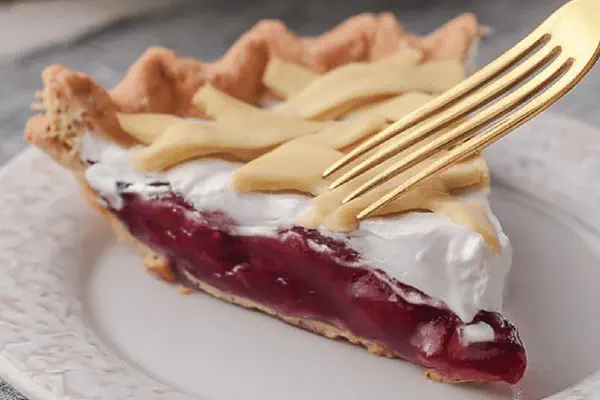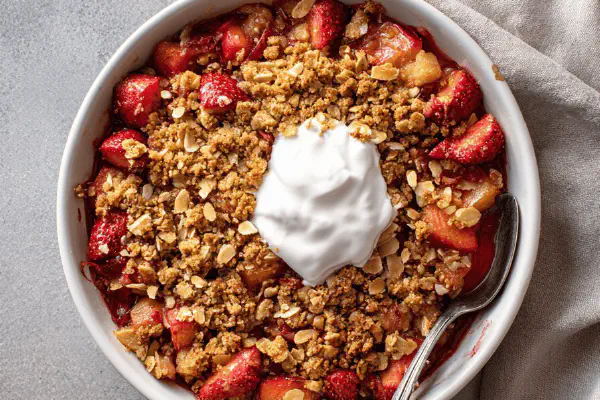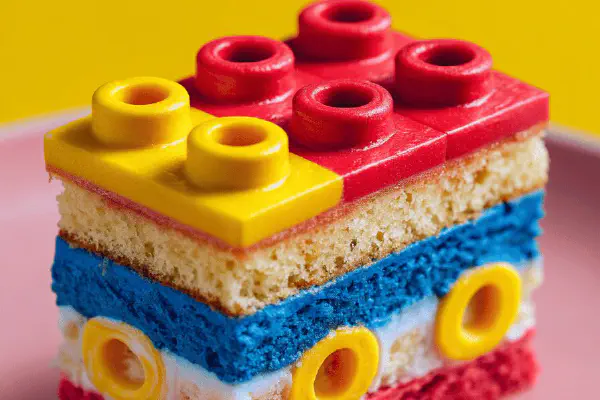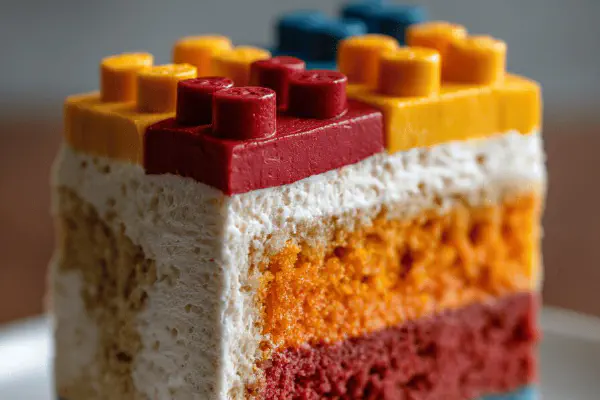Strawberry Chantilly Cake Twist
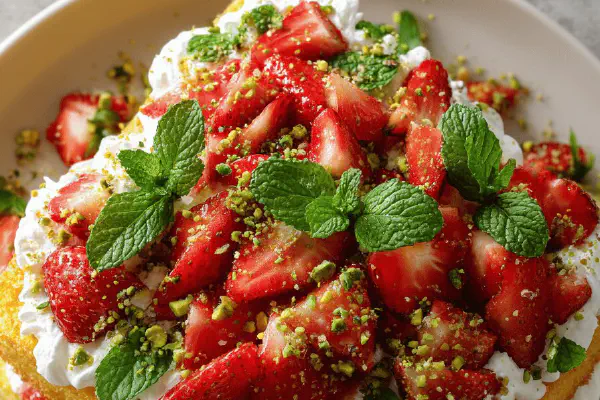
By Emma
Certified Culinary Professional
Ingredients
Cake
- 140 g (1 cup) unbleached all purpose flour
- 60 g (1/2 cup) almond flour
- 5 ml (1 tsp) baking soda
- 2.5 ml (1/2 tsp) salt
- 8 large eggs, whites and yolks separated
- 180 g (3/4 cup) brown sugar, packed
Filling
- 750 g (5 1/2 cups) sliced strawberries
- 45 g (3 tbsp) powdered sugar
- 1 lime, finely zested and juiced
- 30 ml (2 tbsp) fresh orange juice
- 500 ml (2 cups) heavy cream 35%
- 125 g (1/2 cup) mascarpone cheese
- Fresh mint leaves, for decoration
- 30 g crushed pistachios, toasted, for garnish
About the ingredients
Method
Cake
- 1. Get oven ready, rack in center. Preheat to 175 °C (350 °F). Line two 20 cm (8 inch) springform pans with parchment; no greasing. Egg white foam hates grease. I learned this after one flop.
- 2. Mix dry stuff: all purpose flour, almond flour, baking soda and salt. Almond flour adds texture, skip if nut allergy—sub extra flour instead but cake loses depth.
- 3. Whip egg whites till soft peaks form. Hold off on sugar now—the secret is gradual addition to not deflate foam. Set aside.
- 4. In separate bowl, beat yolks with brown sugar until thick, pale, and ribbon stage (about 8 minutes). The brown sugar gives richer caramel notes compared to white. Creaminess visible and silk-like texture important.
- 5. Fold yolks gently into whites, little by little—no rush, that foam is fragile. Then, sift dry ingredients over mixture and delicately fold in with a spatula, preserving air. Don’t overfold or you get dense cake. This takes practice but watch mixture lose volume, stop.
- 6. Divide batter evenly into pans. Smooth top with offset spatula. Tap pans softly on counter to release big air bubbles.
- 7. Bake around 28-30 minutes. Use toothpick test—insert, comes out with few moist crumbs, NOT gooey batter. Edges will pull back slightly from pan when ready. Color should be pale gold, not brown.
- 8. Cool in pans on wire rack for 20-25 minutes. Then invert pans onto rack to loosen layers. Removing too soon causes breakage, too late traps moisture leading to sogginess.
Filling
- 9. Toss sliced strawberries with half powdered sugar, lime zest and juice, and orange juice. Let macerate 20 minutes. The mixture should start releasing shiny, tangy juice.
- 10. Drain berries over bowl. Keep that juice—it’s gold for soaking.
- 11. Whip heavy cream with mascarpone and remaining powdered sugar to firm peaks. Mascarpone stabilizes cream, keeps it from melting too fast—lesson from last summer’s heatwave disaster.
Assembly
- 12. Slice each cake horizontally into two equal layers (total 4). This creates more surfaces for juicy layers.
- 13. Brush three layers generously with the strawberry juice to soak but don’t drown; powder puff sensation is what you want. Use a pastry or silicone brush.
- 14. Spread about 170 ml (3/4 cup) of whipped chantilly on each soaked layer and scatter macerated strawberries evenly over cream.
- 15. Stack layers carefully, finishing with plain cake top (not soaked). Seal cake with remaining chantilly cream all over sides and top for smooth finish.
- 16. Garnish with whole strawberries, a sprinkle of crushed pistachios for texture contrast, and sprigs of fresh mint for brightness.
- 17. Chill at least 1 hour before slicing. Makes cutting cleaner. Can prep a day ahead; flavors meld.
Tips and Tricks
- • If sponge shrinks in oven or crack tops, oven too hot. Adjust temperature down 5 °C next time.
- • No almond flour? Use 200 g flour but expect softer crumb.
- • To fix separated batters, whisk gently but avoid overmixing.
- • If cream gets runny, briefly chill bowl and whisk before retrying.
- • Unsure about doneness? Tap surface, should feel springy, not wet or wobbly.
- • Use slow-motion folding to avoid deflating batter. Too fast? Cake heavy, dense.
- • Keep strawberry juice refrigerated if not using immediately.
- • For extra soak, add a teaspoon of orange liqueur in juice step.
- • Replace pistachios with toasted breadcrumbs for nut-free; adds intriguing crunch.
- • Use superfine sugar if you want cleaner whipped cream texture.
- • Pancake test: a little dollop of raw batter on pan should brown gently—not burn or stay raw.
Cooking tips
Chef's notes
- 💡 Oven temp matters—175 °C, no shortcuts. Watch edges pull back but stay pale gold, hint of bounce on top. Toothpick with moist crumbs is key; gooey means underbaked, dry edges mean too long. Check around 28 minutes; every oven’s a beast. Don’t trust timer only. Parchment essential, no grease. Egg white foam will deflate with fat or grease, careful separation is critical; a trace yolk kills lift.
- 💡 Folding is a slow dance. Use rubber spatula, cut down center, fold thirds, slow circular motion around bowl. Air lost fast if rushed or aggressive. Adding dry mix in thirds helps control volume but keep delicate. I learned folding step-by-step after one dense flop. Don’t overmix or sponge dies; you can see mixture lose volume, stop immediately. Slow, patient turns win over. Whip whites to soft peak only, add sugar last, gradually, else foam weak.
- 💡 Macerate berries for 20 minutes with half powdered sugar, lime zest and juice plus orange juice. Juice drains naturally shiny, sharp. Don’t waste it—use for soaking sponge layers, brush lightly—drowning ruins texture. For extra soak, add tablespoon orange liqueur if desired; scent lifts layers. Whole strawberries scatter in cream for texture contrast, balance tartness with richness. Keep juice chilled to hold freshness if assembly delayed.
- 💡 Whipping cream plus mascarpone creates chantilly thicker, more stable. Scoop cold cream and mascarpone chilled, whip slow till firm peaks form, avoid overwhip or grainy. Skip mascarpone, add stabilizer or whip longer, but risk runny or gritty. Brown sugar in yolks takes longer to dissolve, so 8 minutes beating helps smooth light batter. Brown sugar adds deeper notes versus white’s flat sweetness; if unavailable, sub coconut sugar or white plus 1 tsp molasses.
- 💡 Almond flour adds subtle nuttiness, balances moisture and texture but allergy? Omit, add 60 g extra all purpose flour, expect softer crumb, less chew. Baking soda provides gentle lift without metallic taste if fresh; switch to double action baking powder if taste weird. Cooling upside down prevents shrinking, collapsing—hard lesson learned. Slice cake horizontally into thin layers to soak evenly. Chill at least 1 hour before slicing—clean cuts need firm cream. Always use serrated knife, sharp and steady.
Common questions
How to know when cake is done?
Toothpick test works best. Insert it mid-layer, few moist crumbs cling but no raw batter. Edges pulling back slightly from pan signal readiness. Color pale gold, top bounce lightly. Avoid browned edges. Tap surface, should feel springy, not wet or wobbly. Oven temps differ; check early at 28 minutes, adjust by increments of 2-3 mins if needed.
Can almond flour be omitted?
Yes. Add 60 g extra all purpose flour instead. Expect softer, less textured crumb. Almond flour adds nuttiness and moisture balance. Allergies call for substitute. Don’t replace it with whole wheat or coarse flours, changes outcome. Also watch batter consistency; thicker than usual is normal when swapping.
What if cream runs or separates?
Chill bowl and whisk before retrying. Mascarpone helps stabilize but overwhipping risks grainy texture. If no mascarpone, add cream stabilizer or whip longer carefully. Avoid overheating cream. Cold ingredients key for stable chantilly. Runny cream spells failure in assembly; chill cake well to firm up layers before cutting.
How to store leftovers?
Refrigerate tightly covered, prevents drying and fridge odors. Can freeze individual slices wrapped well, thaw overnight in fridge but texture changes, cream less firm. Best consumed within 2-3 days fresh. Let chilled cake sit at room temp 10 minutes before serving for flavor. Avoid longer storage; whipped cream loses texture and berries soften making cake soggy.
